You've probably heard the stats: The failure rate for innovation projects is 80-90%. And behind every innovation project is...an innovation team.
You may sense this already, but perhaps you haven't quite put your finger on it yet. Why is that everybody builds innovation teams the same way as they do in the Core business, when innovation teams require such different skills and operate in a such different environments? We believe everybody builds innovation teams the wrong way, and that's why 90% of them fail.
Here's how most organizations form innovation teams today. Does this sound familiar?
- They select from available members.
- Assembling diverse functional skills relevant to the project.
- And if possible, include members from different parts of the organization.
- They may give more effort to diversity, and may use personality assessments. But while valuable for other reasons, neither one is associated with better business outcomes.
At Swarm we believe in innovation science, not innovation fairy tales. So we pointed our team of data scientists, behavior economists and developers at this problem statement:
Problem Statement: How might we understand the team factors within our control and significantly improve the success rate of innovation projects?
What is this Problem Costing You?
The inability to innovate costs a company in many ways, including:
- Lower share value vs. your more innovative rivals
- Reduced customer loyalty
- Higher marketing costs and more price discounting
- Greater price elasticity (you raise prices and lose customers as a result)
- Greater hiring costs and higher employee turnover.
But beyond these larger consequences that can feel a bit abstract, let's look at the hard dollars and cents of what failing innovation teams cost you.
The Average Innovation Team Costs $1.2M per year
That's based on a team of eight people at avg. $150k/year salaries each. The “burn rate” to run the team for three years is $1.2M x three years, or $3.6M. That’s before buying, building or testing anything.
The Opportunity Cost When a Team Fails is Much, Much Larger
What is opportunity cost? It's the value the innovation is supposed to deliver to the company, if it's successful. It is usually in the many millions because large orgs won't go after anything that doesn't make a significant impact to their bottom line. In large orgs, the opportunity cost ranges from $1M-$10M savings for a process improvement, to $100M in new revenue for an incremental new product, to $1B revenue growth for a new brand or line of business in an adjacent space.
In most companies, an innovation ceases to be considered “new” after three years. So you multiply the opportunity cost x three years for your total opportunity cost.
The Total Cost of Each Innovation Team = Burn rate + Opportunity cost
Let's take an example team that is going after something modest, say a $10M/year process improvement. The company considers something an innovation only for the first three years it is in the market. So the total cost of this one team is $3.6M burn rate ($1.2M x three years on salaries) + $30M Opportunity cost ($10M x three years), or $33.6M for this one team.
How Many Innovation Teams Are You Running at a Time?
If you're running a Venture Lab or an Innovation Accelerator, the answer may be just a handful. But companies that take innovation seriously (such as packaged goods, aerospace, defense and industrials) tell us they have 60-100 innovation projects going across various units and geographies at any one time. The math quickly becomes daunting.
Let's take a modest case. Say you have just 20 innovation projects going on, each with a team of 8 assigned to it. They're a mix of process improvements, incremental and adjacent innovations:
- 12 process improvements targeting $10M opportunities each = $33.6M each, or $403M total
- 6 incremental innovation projects targeting $100M opportunities each = $303.6M each or $1,822M total
- 2 adjacent innovation projects targeting $1B opportunities each (a new brand or line of business) = $3,003M each or $6,006M total.
The Total Cost of 20 Innovation Teams
So your total portfolio cost is $8,231M, or $8B. If you "only" have a 50% failure rate, you are "only" losing $4B!
No wonder our peers on the Core side of the business sometimes scratch their heads wondering how we innovation leaders can risk this kind of money, and tolerate such an abysmal success rate.
Why Should Innovation Teams Be Formed Differently Than In the Core?
So we have spelled out the cost of innovation team failure. If that is not enough of a reason to look at a different approach, consider this: As we have reported extensively, innovation teams are fundamentally different from Core teams in several ways:
- Innovators and their teams face greater uncertainty. There are fewer guardrails – and not everyone thrives in these conditions.
- They often work outside the core, limiting their access to resources; or face unpredictable resources.
- They face barriers to acceptance, because change inevitably threatens the status quo.
- The core business may see them as lower priority.
- They tend to oscillate between inductive and deductive processes; their work is more “wavy.”
These conditions require very different skills than on the Core business where processes are well-established and where resources, while not unlimited, are more available.
We Made a Major Discovery
In our research, we learned that Serial Innovators are significantly more able to overcome these challenges than the general workforce is. This is true whether they are innovating inside large orgs or outside. Serial innovators possess specific characteristics and skills that predict these positive outcomes with 99% reliability, E.g. They have more drive, interpersonal skills, adaptability, creativity, resourcefulness, and more. And no surprise, teams made up of members with coverage of these serial innovator traits are 3x more likely to succeed.
But guess what? Over 96% of your workforce has at least one of the Serial Innovator traits. These skills are not like magical unicorns. They are all around you, in your workforce, today.
How Serial Innovators Do It
So what are the traits of Serial Innovators? Here is an overview of the Eight Innovation Skills that the Swarm Innovation Profiler measures, and their 26 components: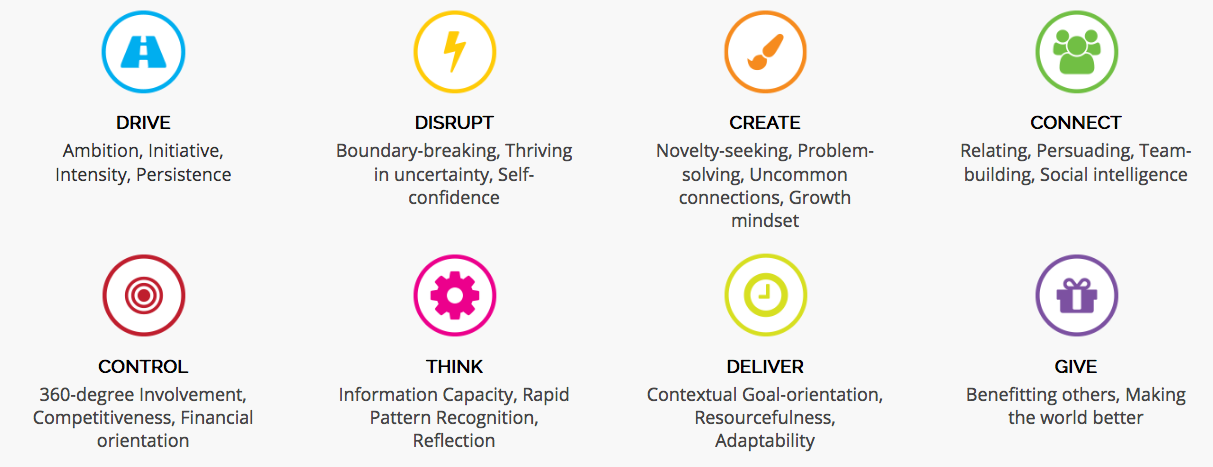
These 8 skills and their 26 sub-skills are highly predictive of business outcomes from innovation, as explained in our published research.
How to Design Stronger Innovation Teams
We have spelled out a leading cause of the high innovation failure rate: the wrong approach to teams. And we sketched out the mind-boggling cost of not fixing it. So what can we do about it?
We propose a three step process that easily fits into your existing innovation processes:
Step 1: Improve the selection process for innovation teams using the Swarm Innovation Profiler
Using the Swarm Innovation Profiler online assessment, discover the hidden innovation talents hiding in your workforce. It's easy, it's inexpensive. And it sheds a whole new, exciting light on your talent pool.
Step 2: Improve existing innovation teams using Swarm Advanced Teams
Using Swarm Advanced Teams, analyze existing teams for coverage of all 8 innovation skills, according to the innovation horizon they're aiming at. (The tool diagnoses gaps and let's you easily search for members by department, region and innovation skills). Optimize the team as soon as you can.
Step 3: Design stronger teams going forward
Then start using Swarm Advanced Teams earlier in the process. Assemble teams from the beginning with diverse functional skills relevant to the project, just as you ordinarily would. Then optimize the team for coverage of all 8 innovation skills, according to the innovation horizon you're aiming at. That usually just means adding or switching out a couple of members.
What Does This Look Like, In Practice?
A picture is worth 1,000 words, so here is an example of a team optimized with Swarm. First the team took the Swarm Innovation Profiler, which takes 20 minutes online. Then the senior leader used Swarm Advanced Teams to instantly analyze the team.
The team leader is from Management, and the members come from diverse backgrounds in Research, Science and Project Management. This team's purpose is Horizon 2/Adjacent Innovation. Yet their average score is in Continuous Improvement. And their Coverage score (the highest score of anyone on the team on each of the 8 skills) is also in the Continuous Improvement range. As it stands, they are not likely to hit their H2 target:
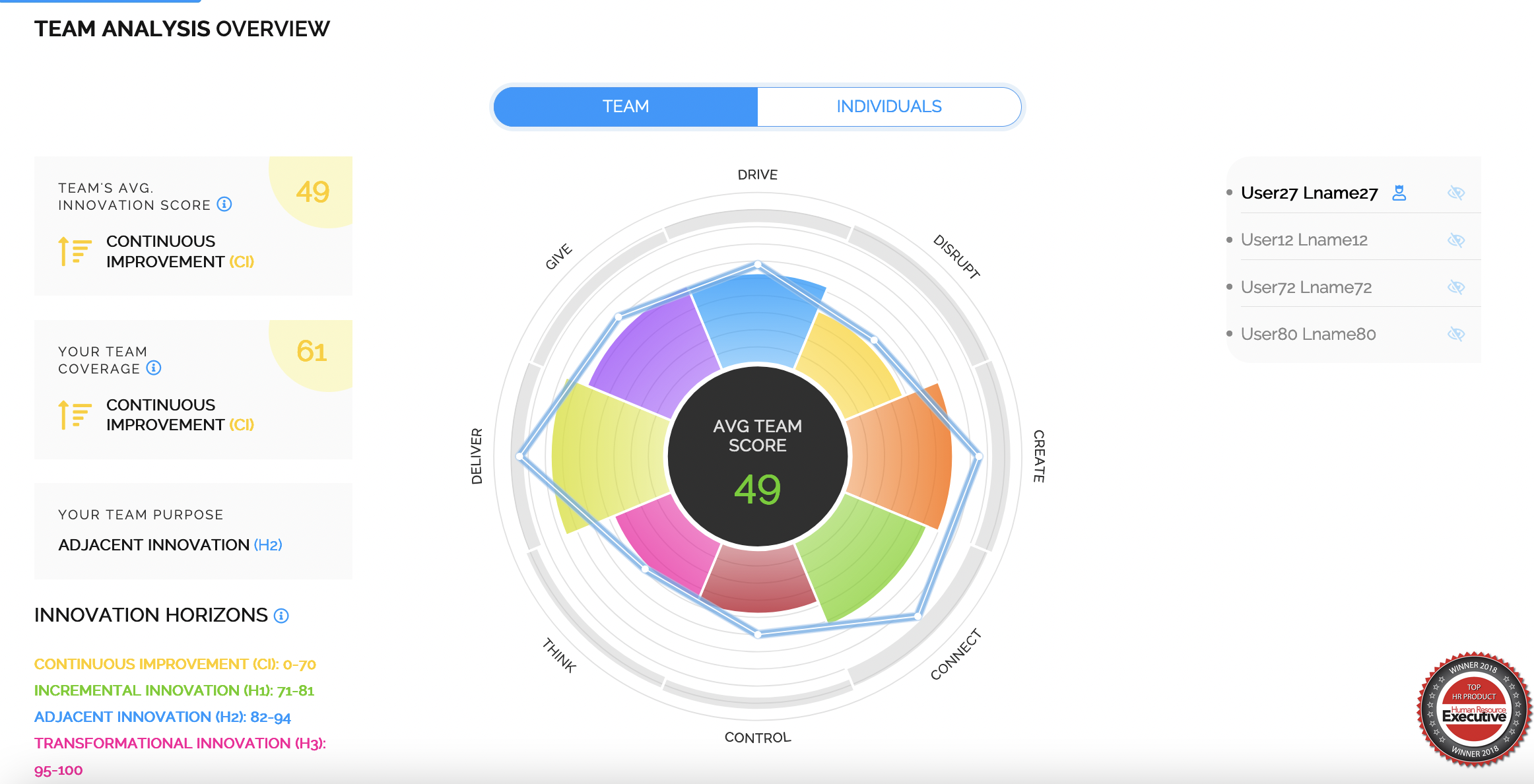
The team leader has several innovation skills in the desired score range (the grey zone), and the essential team-building skills that leaders need. But he/she has significant gaps:
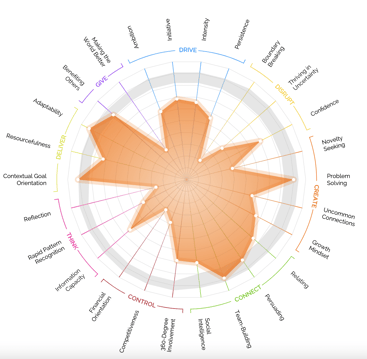
Moreover, while the individual team-members come from diverse functional backgrounds, they are not extending the innovation capabilities of the leader (the orange line). The grey shaded area in the graph is the desired score for H2. As you can see, the team falls short of the desired score range on Drive, Disrupt, Create, Control, Think and Give.

To turn this team from flailing to winning, we want to augment the team's functional skills while also shoring up their innovation skills, the skills that our research proved to be highly predictive of business results. So we add two members with Engineering and Marketing backgrounds who also bring Drive, Disrupt, Create, Control, Think and Give. The team members now nicely extend the team leader's innovation skills:
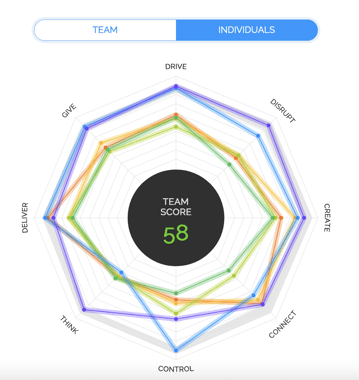
Importantly, none of the existing or new team members had all (or even most) of the innovation skills themselves. But just as you don't need one person to bring all of the functional skills needed on a team, you don't need one person to bring all of the innovation skills either.
This team now has excellent coverage of all 8 innovation skills, and they are highly likely to deliver on their H2 goals:
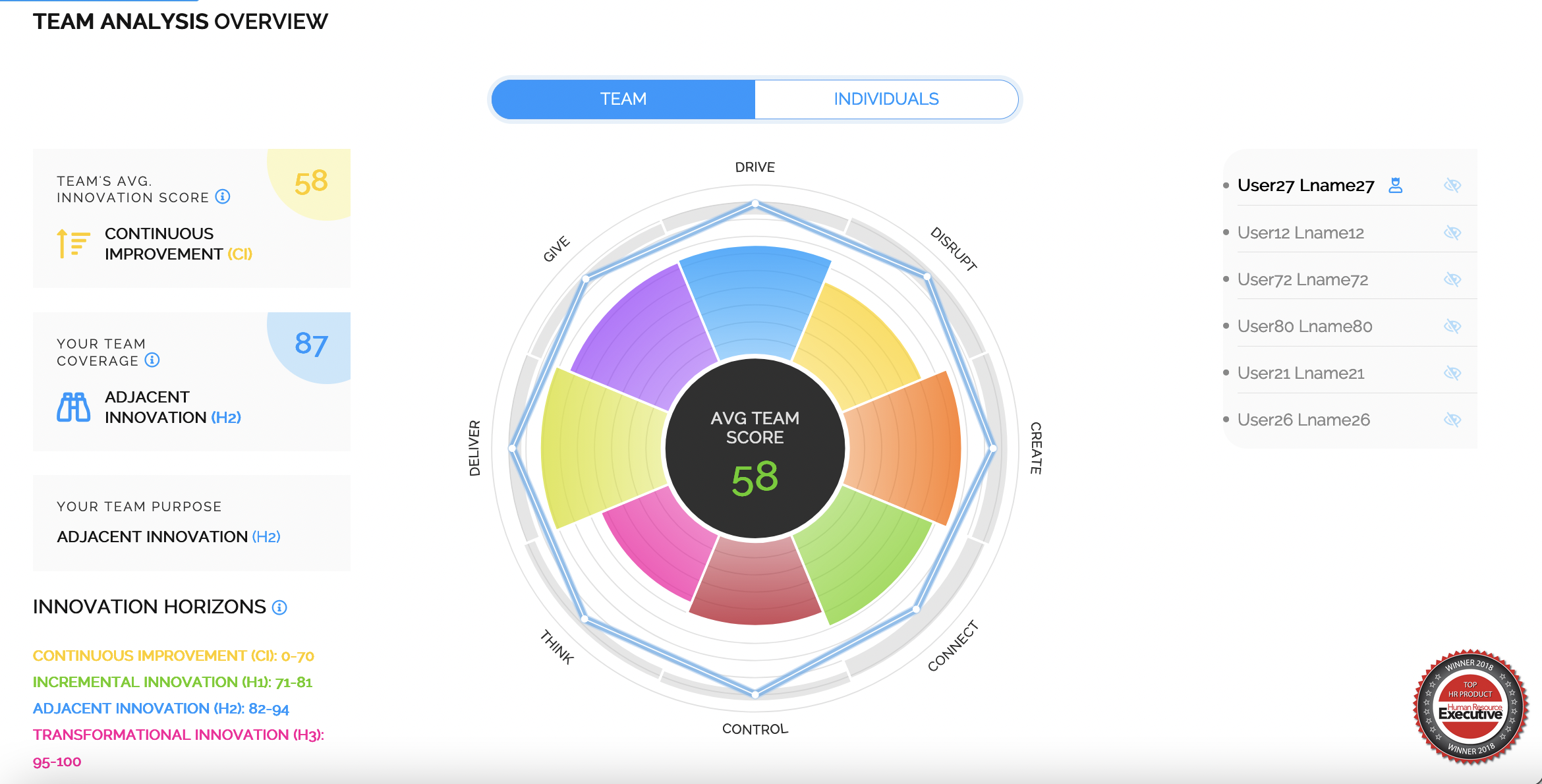
It's that easy.
OK, So How Do I Start?
- First, let's find a time to talk one-on-one about your situation and answer your questions:

- Once you decide to go ahead with Swarm, we suggest you start by comparing some existing strong teams vs. some struggling teams. Gather internal proof.
- Then improve some struggling teams and measure their change in progress. Post some quick wins.
- Finally, apply Swarm earlier in the team formation process for your biggest ROI.
Some Closing Questions for You
We like to work with focused, intentional leaders. So we have some questions for you:
- Are you committed to no longer being prey to an 80-90% innovation project failure rate?
- Are you tired of being subject to unpredictable innovation budgets and wavering support for what you do?
- Are you committed to becoming a serial innovator, repeatably and predictably?
- How would your company’s destiny change when this works?
- How would your life change?
We look forward to hearing from you!
- The Swarm Team

